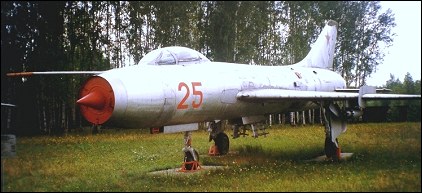 |
Sukhoi Su-7B1959 |  |
| FIGHTER-BOMBER | Virtual Aircraft Museum / USSR / Russia / Sukhoi |
 |
With the change in the VVS FA heavy fighter requirement from a primary air-to-air role to that of ground attack, the Sukhoi OKB undertook revision of the basic S-2 "frontal" fighter as the S-22. Embodying some structural changes to cater for the primarily low-level mission, together with equipment and armament changes, the S-22 retained the highly sweptback (60° at quarter chord) wing, circular-section fuselage and Lyulka AL-7F turbojet of the S-2 (Su-7). The first prototype of the ground attack fighter flew in April 1959. Preparations for series production of the S-22 as the Su-7B (the suffix letter signifying Bombardirovshchik) at Novosibirsk had begun prior to the prototype testing, thus allowing this ground attack fighter to enter the VVS FA inventory early in 1960. The Su-7B possessed a gun armament of twin 30mm cannon, and four external stores stations (two fuselage and two wing) had a theoretical maximum ordnance load of four tonnes. The Su-7B was succeeded in 1961 by the Su-7BM (Modifikatsirovanny) with an AL-7F-1 turbojet, this engine, standardised for all subsequent versions, being rated at 7000kg boosted to 10110kg with afterburning. The Su-7BM (S-22M) also introduced a revised fuel system with prominent external piping ducts along the upper rear fuselage. To improve rough field capability in a version designated Su-7BKL (S-22KL) the flaps were redesigned, provision made for ATO rockets and twin braking chutes, and a unique wheel-skid (kolyosno-lyzhnyi) undercarriage introduced. The main undercarriage members embodied small, extensible steel skids for use on soft ground and were accommodated, when retracted, in bulged bays. The definitive series model introduced in the mid 'sixties and remaining in production into the early 'seventies was the Su-7BMK - the suffix letters signifying modifitsirovanny kolyosny - with new mainwheel members (from which the skids had been eliminated) retracting into flush wheel wells. This modification was accompanied by upgrading of the avionics fit, provision of zero-zero ejection seat and standardisation on a further pair of wing stores pylons as introduced by late Su-7BKLs. Finally withdrawn from VVS-FA first-line service in 1986, the Su-7B was supplied to Afghanistan, Algeria, Czechoslovakia, Egypt, Hungary, India, Iraq, North Korea, Poland, Romania, Syria, Vietnam and South Yemen.

|  COMPANY PROFILE | ||||||||||||||||||||||||||||||||||||||||||||||||
 |

|

